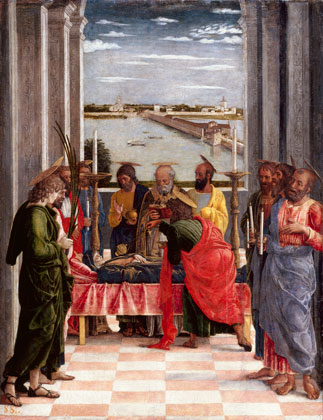First years in Mantua
In 1460 Mantegna entered the service of Marquis Ludovico, thus becoming the official painter of the Gonzaga family, a position he was to hold until his death in 1506. Welcomed with full honors, he was not to leave Mantua again, except for short stays outside, authorized by the Marquis.
Determined to place Mantua in harmony with modernity, it was necessary to dismiss the miniaturist Belbello di Pavia, an adept of the late Gothic style, and to recruit Girolamo da Cremona, an adept of Renaissance ideas.
The first project that he was entrusted with (circa 1460-1464) was the chapel of the Castello di San Giorgio (now destroyed), of which he was responsible for the décor, including the rich wood paneling. Mantegna wanted to astonish his new patron; the Circumcision sparkles with its colored marbles and gilded reliefs, seduces by the precision and truth of its thousand details, while the grievous Death of the Virgin gives us the most beautiful “portrait” ever realized of the town of Mantua, with its bridge San Giorgio, and the rivers and lakes formed by the River Mincio.
Shortly afterwards, Mantegna painted his first Saint Sebastian, a panel of great sophistication; on this sumptuous architecture of composite ruins he insisted on placing his signature in Greek letters.
From 1464 to 1474, Mantegna decorated in the ducal palace, not far from the chapel, a room later known as the Camera degli Sposi (Camera Picta): it was one of the most important enterprises of his career and brought with it immediate celebrity.
Andrea Mantegna (Isola di Carturo, circa 1431 - Mantua, 1506)
Death of the Virgin
1460 - circa 1464
Wood; H. 54 cm; W. 42 cm
Madrid, Musée du Prado, inv. 248
© Museo nacional del Prado, Madrid







